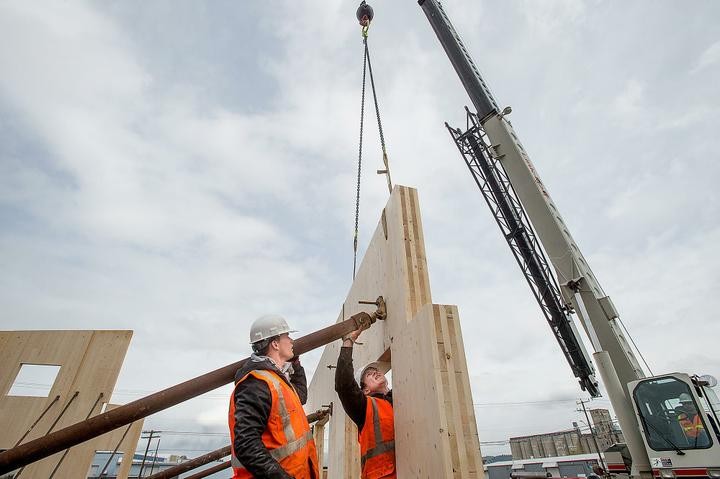On the rise: Local factories part of tall wood-building movement
Sunday, February 17, 2019

(As reported in The Spokesman Review by Becky Kramer)
A Spokane Valley factory could help transform the U.S. building industry, bringing tall, wooden structures into the mainstream.
Building with wood – a renewable resource – is better for the environment than building with steel and concrete, said officials with Katerra Inc.
The Menlo Park, California, company is on track to open an engineered wood products factory in April. The 250,000-square-foot plant will make structural panels from wood that is glued together in layers and compressed. According to Katerra, the factory will be the largest of its kind worldwide.
Katerra’s factory will put Spokane at “the epicenter” of the tall, wooden building movement, said Michael Green, an architect for Katerra in Vancouver, British Columbia. He’s known for his 2013 TED Talk, “Why We Should Build Wooden Skyscrapers.”
A second engineered wood products factory will open in Colville in late April when Vaagen Timbers LLC’s plant comes online.
For decades, fire codes restricted building heights for wooden buildings. Most were capped at four to six stories for safety. Wood was relegated to light-framed construction in single-family housing and low-rise buildings, Green said.
Katerra’s products – cross-laminated timber and glulam beams – are part of what’s referred to as “mass wood construction.” They’re heavier, thicker wood products used as structural building elements, and they make it possible to build mid- and high-rises from wood, Green said.
By virtue of their size, products used in mass wood construction are fire-resistant, said Don Bender, Washington State University’s Weyerhaeuser endowed professor of civil engineering.
“Anybody who has ever tried to start a campfire knows that small pieces burn quickly,” Bender said. “But when you put a big log on, it smolders.”
Cross-laminated timber chars at a rate of 1 1/2 inches per hour.
“While the outside of the wood is slowly charring in a fire, the inner part will still retain its strength,” Bender said.
Advocates for wood construction won a significant victory in December when the International Code Council determined mass wood structures up to 18 stories tall were safe. With taller wooden buildings accepted in building codes, Bender expects them to take off.
“I’ve never seen the architectural community this excited about a material,” he said. “They’ve always liked wood for the beauty and natural warmth, but wood was traditionally used for things like four-story apartments and Marriott hotels. …Now, you are getting into mid-sized buildings. They’re excited about the prospects.”
Glulam beams have been around for about 100 years, while cross-laminated timber was developed in Austria about 30 years ago. Glulam is used for beams and columns in tall, wooden buildings. Cross-laminated timbers are used for walls, roofs, and floors.
Multistory wooden building construction took off in Europe during the 1990s before moving to Canada. Now, Green said, it’s headed to the United States.
Portland currently has one of the United States’ tallest wood buildings – an eight-story condo tower called “Carbon12.” But that project is dwarfed by the University of British Columbia’s Brock Commons Tallwood House, which is 18 stories.
Katerra’s Spokane Valley factory will produce enough material to build 45 commercial office buildings each year, supplying cross-laminated timber to an emerging West Coast market.
The projected output is 50 percent greater than existing European factories, said Robert Malczyk, a director for Katerra. About 150 people will work at the plant when it opens.
The five-story, 150,000-square-foot Catalyst building in Spokane’s University District will be built with Katerra’ products. Green designed the building. As it goes up, local residents will get a chance to see a multistory wood building under construction, he said.
Avista Corp. and McKinstry are partners on the Catalyst building, which will house three-degree programs and 1,000 Eastern Washington University students. Construction will begin this spring.
Vaagen Timbers’ Colville plant initially will employ about 15 hourly workers, said Russ Vaagen, the founder and chief executive.
One of Vaagen’s first projects is the Block House, a 14-unit apartment complex in the Perry District. Construction will begin later this year.
Vaagen said there’s enough market demand for both factories to thrive.
Vaagen Timbers currently is in discussions with developers about 17 building projects, including a 10-story hotel.
“Now, you can now build up to 18 stories within the code,” Vaagen said. “The only caveat is that we have almost no cross-laminated timber production in North America.”
Oregon has one producer. Most of the rest are in Canada.
“Having two major facilities in the area is really going to put Spokane and the region on the map,” Vaagen said.
WSU is part of the equation, too. Faculty in the Composite Materials and Engineering Center are working with Katerra on structural testing and refining the manufacturing process, Bender said.
WSU is the only U.S. university with a large-scale cross-laminated timber manufacturing equipment. The center also has a relationship with Vaagen Timbers.
“We’re glad to provide tech support for both,” he said.
There are compelling reasons to build with wood, Bender said. Producing steel and concrete releases massive amounts of greenhouse gasses. Wood, however, is a carbon sink.
“Trees pull carbon dioxide from the atmosphere, fixing carbon into the wood and releasing oxygen,” he said. “As long as the wood doesn’t burn or decay, it’s helping the overall carbon balance.”
“I think it’s awesome for the state of Washington,” he said of the Katerra and Vaagen factories.
As pioneers in the field, they’re in a position to be pretty profitable because there isn’t much competition, Bender said.
But as production increases and market demand starts to grow, “wood will become an even more economically viable choice for buildings,” he said.